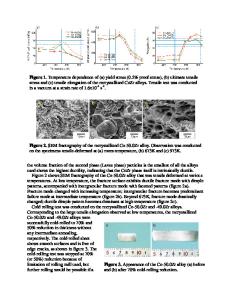Environmental effect on room- temperature ductility of isothermally forged tial- base alloys
- PDF / 3,317,204 Bytes
- 10 Pages / 598.28 x 778.28 pts Page_size
- 75 Downloads / 381 Views
I.
INTRODUCTION
H I G H - s t r e n g t h steels like maraging steels are well known to be affected by the test environment. For example, maraging steels which have been under-aged exhibit lower ductility in air than in vacuum at room temperature, t" and the reduction of ductility results from hydrogen which is caused by the reaction between the moisture in air and steel surface. Many high-strength steels are also reported to be embrittled in a hydrogen gas. 12-6] The reduction of elongation in air at room temperature is also observed for intermetallic compounds like Ni3A1, tT1 Ni3AI-B, t81 Ni3(Mno.4Alo.6), O1 C03Ti, II~ C03Ti base alloys,U u Ni3Si,,21 Ni3(Si, Ti), u31 (Co, fe)3V, 114'15]FeA1,116'17] FeA1-B, u81 FeA1-Cr, u91 and Fe3Al. t171 The fracture surface of specimens tested in air consists mainly of grainboundary facets for Co3Ti, Ni3(Mn, AI), and Ni3Si and of cleavage facets for FeA1 and Fe3AI. This may indicate that the reduction of ductility is caused by the reaction between the moisture in air and the specimen surface which influences the grain-boundary strength for the former intermetallics and the cleavage strength for the latter. Although Chan and Kim reported that the roomtemperature ductility of a Ti-47A1-2.6Nb-2(Cr + V) alloy with a nearly fully lamellar structure was not influenced by the test environment; t2~ we have also reported that TiAl-base alloys consisting of 3,-TiAI and a2-Ti3Al phases exhibit the reduction of bend ductility in air and hydrogen gas in a previous article. ~2" In that report, although the environment affects the room-temperature ductility of approximately stoichiometric alloys, i.e., Ti-50 at. pct A1 and Ti-48.5 at. pct AI-1 at. pct Mn, which exhibit a good bend ductility in vacuum, the ductility of Ti-rich MORIHIKO NAKAMURA, Supervising Researcher, is with the National Research Institute for Metals, Meguro-ku, Tokyo 153, Japall. NAOYUKI 1TOH, formerly with Kougakuin University, Shinjyuku-ku, Tokyo, is now with Nippon Steel Corporation, Kimitsu-shi, Chiba, Japan 299-11. KENKI HASHIMOTO, Senior Researcher, is with the National Research Institute for Metals, Mefuro-ku, Tokyo, Japan. TOKUZO TSUJIMOTO, formerly with National Research Institute for Metals, Meguro-ku, Tokyo, is Professor, Faculty of Engineering, lbaraki University, Hitach-shi, Ibaraki, Japan. TOSHIYUKI SUZUKI, Professor, is with Kougakuin University, Shinjuku-ku, Tokyo, Japan. Manuscript submitted February 14, 1993. METALLURGICALAND MATERIALSTRANSACTIONS A
TiA1 and Al-rich TiA1 which have a poor ductility is hardly affected by the testing environment. Liu and Kim also reported that a 3,-base TiA1 alloy exhibited the lower roomtemperature ductility in air, compared with that in pure oxygen. 1221However, it has not been known how the environment effect on the room-temperature ductility is affected by the microstructure of TiAl-base alloys. In this work, the microstructure of isothermally forged TiAl-base alloys is changed by heat treatment, and the room-temperature ductility is studied in vacuum and air in tensi
Data Loading...











